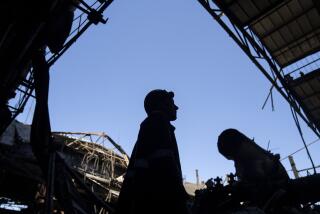Nuclear Accident at Soviet Reactor; ‘Some Casualties’ : Scandinavia Nations Tell of Radiation
- Share via
MOSCOW — A nuclear accident damaged a reactor at the giant Chernobyl atomic power plant in the Ukraine, Tass reported today, injuring an unknown number of people and spewing a radioactive cloud that drifted more than 1,000 miles to Scandinavia.
An unprecedented brief statement admitting the accident was issued by the official Tass press agency after Sweden, Finland and Denmark all reported high levels of radioactivity believed to be from a nuclear accident in the Soviet Union.
Scandinavian officials said their citizens were in no immediate danger from the radioactive crystals, which experts said appeared to have drifted into the region during the weekend.
Reactor Damaged
“An accident has occurred at the Chernobyl atomic power plant as one of the atomic reactors was damaged,” the Tass statement said. “Measures have been undertaken to eliminate the consequences of the accident.”
“Aid is being given to those affected. A government commission has been set up,” said the statement, read on nightly television news.
The accident at the plant--80 miles north of Kiev, the Ukrainian capital with a population of 1.5 million in the western Soviet Union--marked the first time the Soviet Union has acknowledged a nuclear accident, causing Western diplomats to speculate the accident was a major one.
Accident Called the First
Tass said the accident “is the first one in the Soviet Union,” but a 1957 nuclear waste explosion reportedly killed or injured thousands and contaminated a wide area of the Chylabinsk province in the eastern part of the Soviet Union.
It was not immediately clear what effect the radioactive cloud would have on the population of Kiev, situated south of the reactor, as winds blew the cloud north to Scandinavia. Kiev is more than 1,000 miles south of the Swedish border.
Olof Hermander, chief of the Swedish nuclear inspection board, said the discharge probably resulted from a Soviet reactor overheating to let radioactive material escape into the atmosphere, a process he said can lead to reactor meltdown.
In Operation Since 1977
Western diplomats said the Chernobyl plant had four or five 1,000-megawatt reactors. The plant went into operation in 1977, and the fourth reactor went on line in 1984.
“It obviously must be harmful; it sounds harmful to people in Kiev but there is no way to measure the levels of radioactivity,” one Western diplomat said. “I cannot confirm that it is a major accident; there is the possibility they were releasing pressure.”
“The fact that they said anything at all is a big step forward for the Soviet Union,” he said. “It could say something about the level or significance of the accident.”
Swedish Worker Gives Alarm
The accident first came to light after a worker at the Swedish Forsmark nuclear power plant set off an alarm this morning when his clothes registered unusually high radiation levels. Authorities quickly evacuated 600 employees, but experts were unable to explain the occurrence until radiation readings were taken in other parts of Sweden.
“The radiation was measured to some millirem per hour, a dose unharmful for people, but clearly unallowable,” said Swedish energy board spokesman Olle Blomqvist.
“Analysis showed it came from a nuclear power plant,” he added.
“We have registered radioactivity just about everywhere we have looked,” said Ragnar Boge of the Swedish Radioactive Institute. “They have found unusual concentrations in Denmark, and yesterday they found even higher concentrations in Finland.”
The worst U.S. commercial nuclear accident occurred March 28, 1979, when radiation was released from the Three Mile Island nuclear power plant near Harrisburg, Pa. About 144,000 people were evacuated during the crisis, later blamed on human and mechanical failures.
More to Read
Sign up for Essential California
The most important California stories and recommendations in your inbox every morning.
You may occasionally receive promotional content from the Los Angeles Times.













